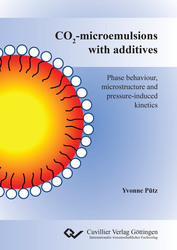| Departments | |
|---|---|
| Book Series (96) |
1378
|
| Nachhaltigkeit |
3
|
| Gesundheitswesen |
1
|
| Humanities |
2364
|
| Natural Sciences |
5406
|
| Mathematics | 229 |
| Informatics | 319 |
| Physics | 980 |
| Chemistry | 1363 |
| Geosciences | 131 |
| Human medicine | 243 |
| Stomatology | 10 |
| Veterinary medicine | 108 |
| Pharmacy | 147 |
| Biology | 835 |
| Biochemistry, molecular biology, gene technology | 121 |
| Biophysics | 25 |
| Domestic and nutritional science | 45 |
| Agricultural science | 1004 |
| Forest science | 201 |
| Horticultural science | 20 |
| Environmental research, ecology and landscape conservation | 148 |
| Engineering |
1793
|
| Common |
98
|
|
Leitlinien Unfallchirurgie
5. Auflage bestellen |
|
Advanced Search
CO2-microemulsions with additives (English shop)
Phase behaviour, microstructure and pressure-induced kinetics
Yvonne Pütz (Author)Preview
Table of Contents, PDF (58 KB)
Extract, PDF (510 KB)
Improved building insulation is an important part of today´s efforts on energy saving. Here, nano-insulation materials promise especially low thermal conductivity. Therefore, an easy and cost-efficient production of these materials is an aim of present material research. One approach towards these materials is the expansion and fixation of polymerisable microemulsions of supercritical blowing agents. However, the nano-sized bubbles are found to undergo undesired coarsening processes. In order to reduce the increasing interfacial tension emerging during expansion and therewith the coarsening it was suggested to add low-molecular hydrophobic substances to the supercritical microemulsion. And indeed, the addition of cyclohexane to a microemulsion of the type brine – CO2 – fluorinated surfactants was found to reduce the fluorinated surfactant content – a measure for the interfacial tension – considerably. In this work a systematic small-angle neutron scattering (SANS) contrast variation was performed and the data were analysed by model-independent Fourier analysis. It was found that a concentration gradient of cyclohexane inside the CO2/cyclohexane microemulsion droplets forms. Interestingly, the analysis reveals a depletion zone close to the amphiphilic film which presumably develops due to the known repulsive interactions of cyclohexane and the fluorinated surfactant tails. Using a specially designed high pressure SANS cell to perform stroboscopic pressure jumps, the influence of cyclohexane on pressure-induced elongation of microemulsion droplets as well as the early state of foaming after expansion was studied. Here, the pressure-dependent thermodynamic stability of such microemulsions allows for a fast repeatability of the pressure cycles. It turned out that cyclohexane systematically slows down the structural changes in all processes. Parallel pressure jump experiments with poly-(N-isopropylacrylamide) (PNIPAM) particles revealed that hydration and dehydration kinetics can be studied with the same experimental setup. The first kinetic experiments which combine a CO2-microemulsion mixed with PNIPAM particles indicate that PNIPAM acts as a stabiliser for the microemulsion and further reduces the thermodynamic driving force of the demixing process.
| ISBN-13 (Hard Copy) | 9783736990425 |
| ISBN-13 (eBook) | 9783736980426 |
| Final Book Format | A5 |
| Language | English |
| Page Number | 220 |
| Lamination of Cover | matt |
| Edition | 1. Aufl. |
| Publication Place | Göttingen |
| Place of Dissertation | Köln |
| Publication Date | 2015-07-20 |
| General Categorization | Dissertation |
| Departments |
Chemistry
Physical chemistry |
| Keywords | CO2-microemulsions, pressure jumps, kinetics, PNIPAM, Scattering |








